Archive for the ‘Sculptures’ Category
Chul Hyun Ahn, Contemporary Sculpture, Korean Sculpture, Leo Villareal, Light, Light Art, Light Sculpture, Olafur Eliasson, optical illusion
In Sculpture Personalities, Sculpture Techniques, Sculptures on April 7, 2017 at 1:30 am
Chul Hyun Ahn‘s career in art started as a graduate of Chugye University for the Arts located in Seoul. He graduated as a bachelor of fine arts, and later moved on to study his masters degree at the. Maryland Institute College of Art (Baltimore) 2002. This peculiar sculptor does not use the traditional stylings of classical sculptors, but rather employs a new media that takes viewers by surprise; light energy.
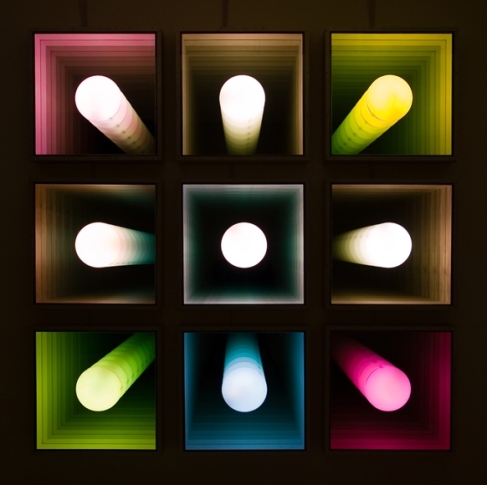
(Photography by Bmore Art – 2005 – Sculpture by Chul Hyun Ahn)
His first exhibition was with C. Grimaldis Gallery. It featured six of his light sculptures and was a ground breaking event in Ahn’s young life at the time. He eventually became a member of a group of light artists that included Olafur Eliasson with Leo Villareal, and Ivan Navarro. Ahn frequented the theme of infinity and zen, creating pieces that reflected on the meditation of these thoughts. People have called his pioneering works as marvels that serve as portholes into another world of chiaroscuro. He institutes the principles of illusional optics and mindplay with several of his more recent works. Ahn’s evolution in the field of light art is a proud step for the artist circles of Korea in the global eye.
Contemporary Sculpture, Ezra Orion, Geologic Sculpture, Geometric Art, Geometric Sculpture, Israel Sculpture, Minimalism, Minimalistic Art, Minimalistic Sculpture, Royal College of Art
In Sculpture Architecture, Sculpture Personalities, Sculpture Techniques, Sculptures on December 22, 2016 at 2:38 pm
As we’ve gotten more and more involved with abstract creations lately, let me show you a sculpture that attunes to a more primal form. Here we have a piece made by the Israeli sculptor Ezra Orion. Don’t let the fantasy-like name fool you, this is one talented artist when it comes to sculptures like this 1966 iron artwork. Resembling the silhouette of an steel beam, Orion’s creation subtly plays with the field of geometry within the piece’s lined interior. Reflecting a vertical boldness and a sense of finality, the piece is indeed a “launching pad for the mind” as described by Orion himself in the past. A graduate of the Royal College of Art in London and the Central Saint Martin’s College of Art and Design, Orion’s geologic pieces stand tall as a premier example of art that expresses itself in the most basic, yet relational expressions.

Orion‘s piece was a resident of the Israel Museum in Jerusalem and remained one of its aesthetic collection pieces for a long time. When dealing with geometrically inclined subjects, there are times when the mind simply wanders too near the actual contour of the original model, however the challenge is creating that subtle difference in the shape, color texture or other element involved with the artform. Orion’s strong pieces reflect as a basal and concrete idea by which an audience can begin to imagine as something personally interpretable (as anything). The advantages of a basic form allows for the wandering of the mind. On one side, the disadvantage of being too close to the original subject, and on the other the benefit of having a limitless number of possibilities to expound. As the year draws to a close, we hope artists and sculptors out there have gotten a new grip on what it means to create art. The aesthetic community is changing, and so are many of its players.
Alan Thornhill, British Sculpture, Contemporary Sculpture, Modern Art, Modern Sculpture, Random Sculpture, Raw Sculpture, Spontaneous Art
In Sculpture Personalities, Sculpture Techniques, Sculptures on June 16, 2011 at 8:57 am
Alan Thornhill is a British sculptor who devised his own way of clay-working his sculptural artworks. He creates their composition initially our of course clay parts in a somewhat random selection and does not use the traditional guidance of a wire armature (as do most sculptors). The clay parts are either kiln fired as a whole or cut up and fired individually before re-assembly.
Born in 1921, Thornhill developed his artistic interest from a base knowledge of pottery to a spontaneous development of sculpture. His raw method of sculpting gave room to improvisation. On the other hand his interest in sculpted portraiture challenges the notions of standard and normality. Before his journey into art, Thornhill did several things in his life, including service in the army, and studying up to be a modern historian. In the late 1940’s however, he was accepted into the Camberwood School of Art and studied pottery under Nora Braden. Eventually Thornhill became somewhat frustrated at the repetition involved with creating pottery works. His random nature gave way to the evolution of his interest and he moved to London in 1959 to create his own sculpture studio.
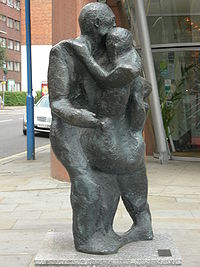
Sculpture by Alan Thornhill, Photography by Magnus Manske
His sculpture; “The Bond” was purchased by the Jerwood Foundation and stands today at Ragley Hall. His daughter; Anna Thornill had also created a 40 minute documentary on him and released it in 2008. The biographical film was entitled “Spirit In Mass : Journey Into Sculpture” and had won an award from Screen South and the UK Film Council.
Abstract Surrealist Sculpture, Contemporary Sculpture, Joan Miró, Lunar Bird Sculpture, Modern Sculpture, Moon Bird Sculpture, Surrealist Sculpture
In Sculpture History, Sculpture Personalities, Sculptures on May 17, 2011 at 6:41 am
In 1945, the famous sculptor; Joan Miró i Ferrà created an abstract creation entitled Lunar bird. The actual piece was then finally enlarged and cast in 1967. Currenty, Lunar Bird exists as a permanent resident of the Hirshhorn Museum and Sculpture Garden. Miró’s patronized usage of surrealist subject within both is paintings and sculptures became a manner people came to love about his style. Despite beginning his career as an accountant, Miró grew to epic proportions during the course of his artistic life. He garnered several awards and recognitions in the international art community, such as the Venice Biennale in 1954 and the Guggenheim International Award in 1958.
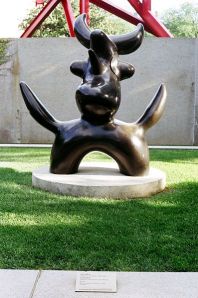
Photography by Ben Javelina, Austin Town – Sculpture by Joan Miró i Ferrà
In 2006, the Artists Rights Society who managed the copyrights of Miró’s works had a clash of interest with Google when they allegedly used his work for a modified logo or graphic. This did not trail on though, because Google simply complied with their request to have it taken down, but denied any violation of copyright. Miró was also mentioned in Paulo Coelho’s famous work; Eleven Minutes. A fun fact here: Miró’s sculpture entitled “Moonbird” can be found on the campus of Springfield University on the popular show; The Simpsons (Episode: “That 90’s Show”)
Blackpool High Tide Organ, Blackpool Sculptures, Kinetic Musical Art, Kinetic Sculpture, Musical Monuments, Musical Sculpture, Sea Sculpture, The Great Promenade Show, Tide Sculpture
In Art Hotspots, Sculptures on April 22, 2011 at 11:52 am
Standing about 15 meters in height, the Blackpool High Tide Organ Sculpture along Blackpool’s New Promenade was the brainchild of artists Liam Curtin and John Gooding. Most of its raw material was found from steel and copper sheets. This interesting monument is not only a sight for any musicians eyes, but it is also a kinetic sculpture. It promotes a blending of art media by being an interactive piece that resonates through its eighteen pipes when the coastline is at high tide. The organ pipes are also connected to eight pipes attached to the sea wall. The ideal hours to experience this musical sculpture is about two hours before or after high tide.

Photography by Matt Kitty from Lancashire
The sculptural monument was part of The Great Promenade Show series. It was often described by the community as something which was able to materialize the musical inclinations of the sea itself. It’s elongated structure also makes it a wonderful sight for tourists and visiting musicians.
The Blackpool High Tide Organ is one of the rare musically interactive sculptures that do not require much of man’s additional intervention. Other examples include the famous Aeolian Harp and the Wind Chime.
Commemorative Art, Gilgal Sculpture Garden, Personal Art, Salt Lake, Sculpture Garden, Thomas Battersby Child, Utah Sculpture
In Art Hotspots, Sculpture Personalities, Sculptures on March 23, 2011 at 2:04 am
Thomas Battersby Child, Jr. had the idea of creating a sculpture garden to become a retreat into his own religious and personal beliefs. Child was not a professional artist, but he was someone who was very particular for detail and perfection. He created the Gilgal Sculpture Garden in Salt Lake City, Utah during the 1900’s. The entire complex contains 12 original sculptures and around seventy stones that are engraved with scriptures and excerpts from literature.

The word “Gilgal” means “circle of standing stones” and was the name given to the garden by Child who was inspired by the location in the Bible where Joshua and the Israelites used 12 stones to convey a memorial.
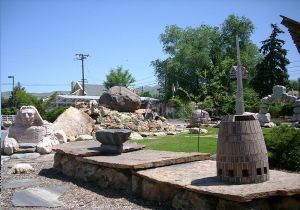
Child completed his own artist’s workshop in order to undertake this endeavor of building the garden. He went to great lengths to complete every piece on the location site itself, and even used unconventional tools such as an oxyacetylene torch. Some of the finished sculpture are as follows: A Sacrificial altar, a shrine to Child’s wife and a sphinx with the face of Mormon prophet Joseph Smith Jr. What Child wanted to convey was not a sense of agreement with the world. People did not have to see his way of thinking or submit to his point of view, but rather just stop and be aroused by the curiosity of his works. Despite its long lasting existence, the Gilgal garden is now in the process of reparation.
ancient sculpture, Cholas Culture, Cholas Sculpture, commemorative sculpture, Indian Art, Indian Sculpture, Temple Sculpture
In Sculpture Architecture, Sculpture History, Sculptures on March 23, 2011 at 1:46 am
The Cholas were a culture that built a strong foundation of sculpted architecture in 850 -1250 CE. They refined the styles of Dravidian art and created intricate bronze and stone sculptures and temples that were made to last for generations. During the middle period of their golden age, we can observe that projects and conquests of Rajendra Chola and his son; Rajendra Chola I. They built a number of temples in their culture’s unique architectural styles. Many ruins and remnants of these ancient structures still stand tall today because of their amazing engineering and design capabilities during the Chola period. One of these famous temples is the Tiruvalisvaram temple near Tirunelveli. These temples were of a very intricate and detailed design. From afar, they resembled the ascending orientation of Egyptian pyramids, but up close, a stylistic manner of sculpture and ornamental carvings can be visible to the eye.
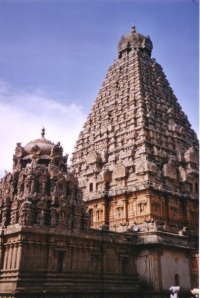
Two of the greatest Chola temples are the Thanjavur and Gangaikondacholapuram. The first was completed around 1009 CE and is a memorial to the achievements made during the Rajendra reign. It is also the largest and tallest masterpiece in South Indian historical art culture. The two towers that surround the temple are called gopuras. Despite their massive size, the gopuras do not steal away the focus on the main temple itself because of the way they were constructed. The architecture revolves on the main temple through the flow of design composition within the entire complex. The Cholas were historically some of the best architects of their time, and today their incredible accomplishments still puzzle the modern world in more ways than even they could have imagined.
ancient sculpture, bronze age, commemorative sculpture, cultural art, cultural sculpture, dove sculpture, Vučedol sculpture
In Sculpture History, Sculptures on March 23, 2011 at 1:21 am
Some archaeologists have found many interesting ceramic artworks from ancient Vučedol culture. Many of these are are cut decoratively with specific geometric traits and blackish hues. More characteristics of ancient ceramic vases and sculptures are a high glow, skillful inlay of colors and symbolical orientation. The photograph below is one artifact that was found and salvaged. It’s the Vučedol dove and was the primary symbol of their culture at the time. The traditionally incrusted colors aren’t visible on this specific piece, however you can evidently see the geometric cutting patterns made by the craftsman.

Vučedol cultural art could also give us a glimpse of how they lived long ago. The artwork mildly resembles some elements in their lifestyle, such as their half-buried mushroom-like housing system. They also chose to reside on hilltops with palisade walls. The sculpture of the dove reveals the shape of the hilltop where the head stands out overlooking the valley. It also gives a similar comparison to the way their houses looked. In time, Vučedol culture gave birth to the Bronze age Vinkovci culture that is now known for their usage of fibulas made of bronze. Every single race holds art and artifacts that we can trace back to significant hitorical findings, but it’s a pleasure to know where our past ancestors have gone in the search for artistic passions.
Abstract Sculpture, Art Appreciation, Collecting sculptures, Large Scale Sculpture, Modern Art, Modern Sculpture, Public Art, Sculptures
In Art Hotspots, Sculpture Techniques, Sculptures on March 11, 2011 at 6:46 am
I thought that with the release of the new Yogi Bear movie, I’d publish this post for a little twist. The Longaberger Company manufactures handcrafted lifestyle products like wooden baskets and fabric products. A perfect symbol of their hard work can be seen even before you enter their building’s lobby floor. Shaped like a huge picnic basket, their headquarters in Newark, Ohio is a prime example of sculptural application in architecture. There are many examples of large-scale sculptures all over the world by commercial or private artists.

I heard that an advertisement for an Adidas football product was done recreating a football field on an elevated billboard. two players would hang by their sides and play a game of football in side-ways gravity. These types of sculptural applications can be very insightful and lend a smile to you daily dose of sights. It’s a good change from the regular ugly paraphernalia of marketing gurus and sales agents. Embodying what you do through the craft of sculpture is really admirable and a good contribution to the creative influence of others.
When sculpture intertwines with everyday life, that’s when it’s most appreciated. Sculptors and artists take pride in what they do, and what better fulfillment than having people use and live in your artworks. These days, the bar is set higher and higher for creative innovation. Where will our ideas take us in ten or twenty years? I propose holographic sculptures.
Abstract Sculpture, Art Appreciation, fiberglass sculpture, John Buckley, Modern Art, Modern Sculpture, Sculpture, The Headington Shark
In Sculpture Personalities, Sculptures on March 11, 2011 at 6:32 am
Well this isn’t something you see everyday, even if you’re a scuba diver. The Headington shark is a sculpture that was made to symbolize the reaction to the attrocities commited at Nagasaki. It’s suppose to be likened to the nuclear power used against innocent people when bombs were dropped from the sky. The sculpture is about two hundred kilograms and is made of fiberglass. In 2007, it was renovated by the sculptor who built it.

Sculpture bu John Buckler – Photography by Henry Flower
Sometimes contemporary sculpture need not neccessarilly be appealing in the sense of visual beauty, but the depth of meaning behind the artwork must stand out one way or another. The Headington Shark is a perfect example of contemporary art that makes you wonder what on earth the artist was thinking. It draws you in to discover the history of its inspiration and story. John Buckley; it’s creator, was a genius when he created such a bold, yet curious piece. The shark wasn’t always appreciated though. A long time ago, the Oxford City Council tried to have it removed and relocated to a local swimming pool, but the people had grown too much attachment to the sculpture that it ended up staying right where it was.










